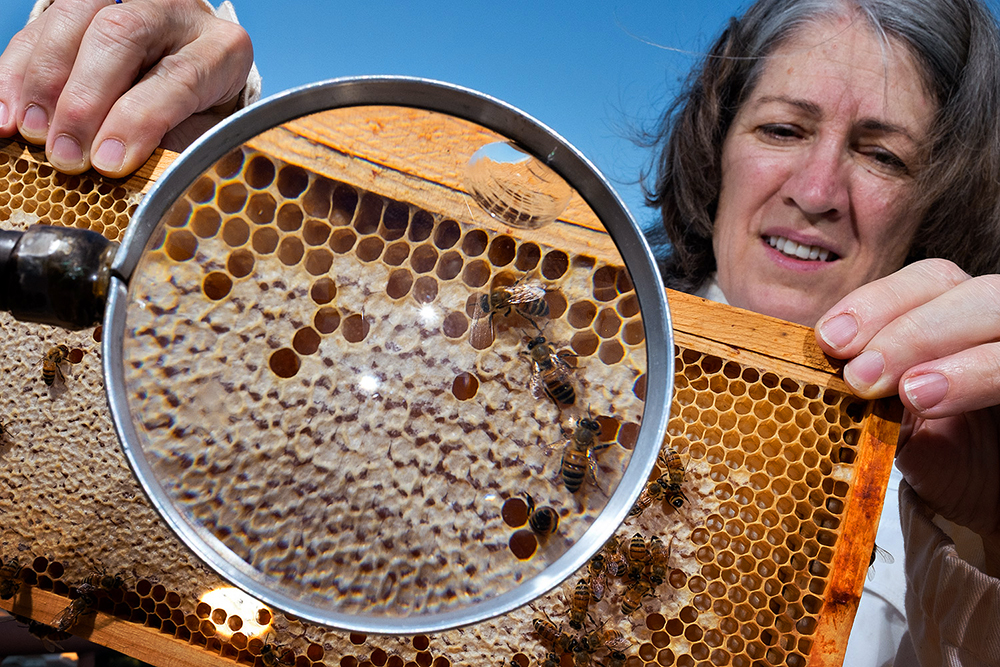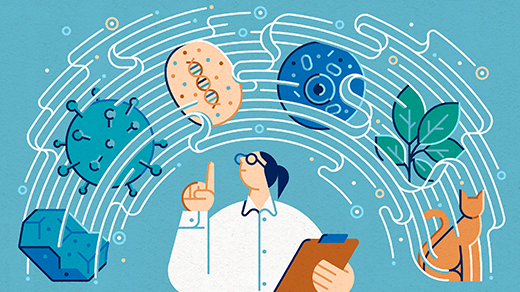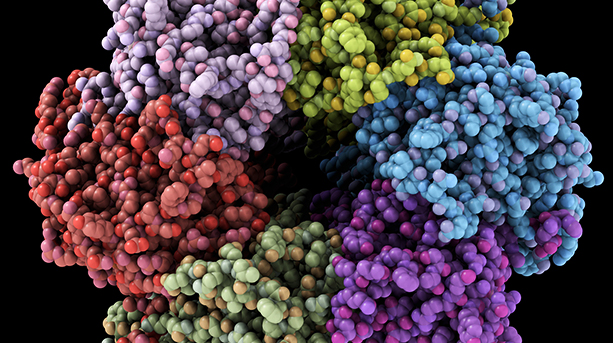An Explorer of Life’s Deepest Partnerships

Two years ago, Nancy Moran moved from Yale University to the University of Texas, Austin, along with 120,000 bees. Bees are famous for living in large social groups, but Moran was interested in more than just the hive: She’s delving into the diverse ecosystem of bacteria that evolved along with the bees, a group that contributes to the health of hives and their resilience to infection.
Bees and their microbiota are just one example of symbiosis — a close relationship between two species that typically helps both. Symbiosis can take a variety of forms. Cleaner fish scour dead skin from other fish and gain a meal in the process. The myriad microbes that live within our guts help us digest certain foods.
But much of Moran’s work has focused on a deeper kind of partnership, one involving microbes known as endosymbionts that are passed from their host to its offspring. With her collaborator Paul Baumann, a bacteriologist at the University of California, Davis, Moran uncovered the tightly interwoven nature of these host-microbe relationships. Many pairs have become completely dependent on each other, some even swapping genes. Her research centered largely on aphids, sap-feeding insects that infest plants. The aphids can’t survive without a microbe called Buchnera aphidicola, which lives within the insect and provides it with essential nutrients.
Moran is now doing similar work with bees, and her research could eventually help scientists understand colony collapse disorder, the mysterious plague devastating honeybee populations. Moran hopes an evolutionary biologist’s perspective will also provide important insight into the workings of the human microbiome — the collection of microbes that live on and inside us — which has become a hot topic in human health.
Quanta Magazine spoke with Moran in July at the Society for Molecular Biology and Evolution conference in Vienna, where she presented her latest research on bees. An edited and condensed version of the interview follows.
QUANTA MAGAZINE: What was the field of symbiosis like when you started in the 1980s?
NANCY MORAN: It was a fringe topic in biology at the time. Most symbionts can’t be studied outside their host, and everyone was ignoring them. There were very limited tools for studying them. Then in the 1980s, new molecular methods became available to amplify DNA and then sequence it.
How did you use those tools to study symbiosis?
One of the first things we did was create an evolutionary tree for aphids and their resident bacteria, Buchnera. We figured out they had coevolved for more than 100 million years, since aphids first appeared. Aphids basically wouldn’t exist without symbionts. We found that pattern to be quite widespread. Major groups of insects evolved because they had symbionts.
How do symbionts help their insect hosts?
They often provide nutrition. Aphids live on plant sap, which is unsuitable for animals because it doesn’t have all the essential amino acids. Buchnera makes essential amino acids for them. The tsetse fly, which feeds on blood, has a symbiont that makes B vitamins. Using genomics, we have been able to find the exact genes that are required for making nutrients such as amino acids or vitamins.
How do symbionts change in response to their hosts?
When we started to sequence whole genomes of symbiotic bacteria, we realized they had unusual patterns of gene evolution. Endosymbionts often lose lots of genes. In fact, the extreme tininess of some of the endosymbiont genomes was a surprise when we started, so much so that we didn’t believe our initial results. For the aphid-Buchnera case, the genome size of the Buchnera symbiont had been predicted to be seven times the size of the E. coli genome, when in fact it was only one-seventh the size!
When a symbiont becomes integrated with a host so closely, the result is something like a totally new creature, a fusion of the host and symbiont, that now has capabilities not present in either one alone.
You’ve discovered that sometimes symbiotic relationships are more complex than simply host and symbiont. Can you give us an example?
Aphids have symbiotic bacteria called Hamiltonella defensa that protect them against wasps. But the bacteria are only protective if they’re infected by a certain virus. So the virus, within the symbiont, within the aphid, is protecting all of them. It’s a multilevel system; all three benefit if the aphid is resistant to the wasp.
I think I am drawn to the complexity of these things that come about during evolution. They look so complicated and elaborate, but you can understand them if you think about how selection acted at different levels.
The term symbiosis generally refers to a helpful relationship between two species. But you caution that it can have a downside.
Symbionts aren’t always good. The evolutionary interests of bacteria can be in agreement with those of the host, or against them. Symbiotic bacteria might evolve to benefit the host so that the host will live longer (and continue providing a home for the bacteria). Or the bacteria might kill the host, so that the host corpse will disperse microbes. For example, Photorhabdus luminescens is a gut symbiont of nematode worms. The nematodes colonize an insect, and the P. luminescens exits the nematodes, infects the insect, and kills it. Then the nematodes take up the bacteria and travel to a new host.
In the last few years, you’ve moved from studying aphids and endosymbionts to bees and their microbes. What inspired the change?
It’s very difficult to perform experiments on endosymbionts because the organisms need them to survive. You can’t remove the symbiont and see what happens.
What drew you to bees?
Bees are social insects, which gives microbes the opportunity to be transferred from animal to animal. In this way, the bee microbiome is a lot like the human microbiome.
How can the bee microbiome help us understand the human version?
Different bee colonies have different strains with different gene collections, just as people have their own unique collection of microbes.
In human microbiome studies, the links between the microbiome and health are correlative. We rarely have causative data. In bees, we can do more direct experiments. We can do something to the colony and see if it thrives or fails. For example, we isolate pupae in the lab and inoculate the emerging adult bees with specific bacteria. It’s a simpler system but still complex.
What do you hope to learn about bee health?
Clean bees, those with no microbes, may be worse at dealing with environmental challenges, such as food shortages, stress and pathogens. There’s some evidence that certain bacterial strains can protect honeybees against an RNA virus that is the species’ most common and deadly pathogen. The virus is widespread in bees, and it kills some colonies but seems innocuous in others. Why? It probably has to do with the microbiome and how resilient the colony is.
Bill McCullough for Quanta Magazine
Video: Moran explains how colony collapse disorder led her to study the bacteria that live in the guts of bees.
Will your work identify potential causes of colony collapse disorder?
It’s only speculation at this point. But you can imagine that a naturally occurring bee colony has little exposure to other colonies. A microbe will survive only if its host colony survives. But commercial bees are raised closer together than in the wild, so there’s more opportunity for microbes to spread among colonies. If you take a lot of colonies and put them a few feet apart, you could create conditions where there’s greater advantage [from the microbe’s perspective] to invading other colonies rather than relying on a single host. That could select for bacteria that are harmful to the colony — for example those that cause the bees to develop diarrhea and spread the microbe. Modeling studies based on human pathogens suggest that lots of social contact could create more-harmful microbes.
Over the last 30 years, symbiosis has transformed from an unpopular area of research to a trendy topic — the human microbiome is the subject of thousands of publications. What’s missing from the latest studies?
Nowadays, we see a lot of headlines that assume a diverse microbiota is good. The general tone, even among biologists — except for evolutionary biologists — is that it’s all beneficial. But diversity can be good or bad. An evolutionary perspective might provide some balance. We need to understand evolutionary processes at different levels, such as between a host and its microbes, and among different kinds of bacteria living inside the host.
This article was reprinted on ScientificAmerican.com.



